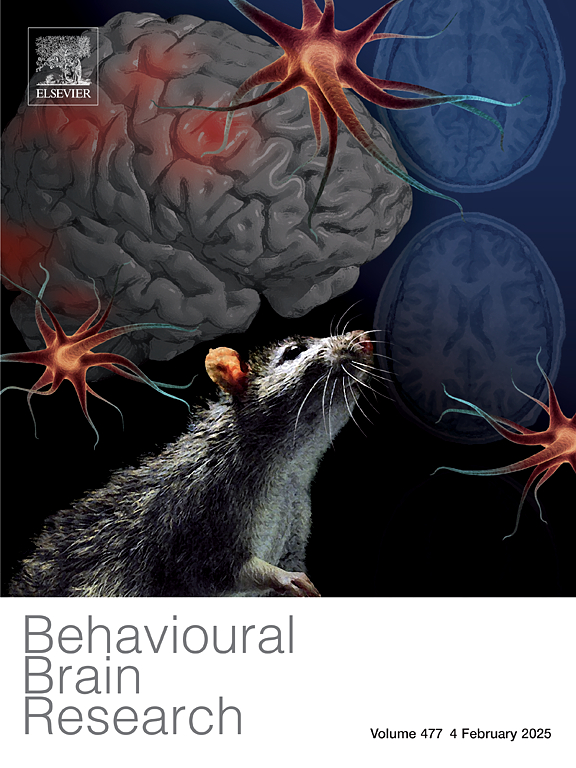The serotonin precursor 5-HTP and the serotonin releaser fenfluramine but not the serotonin reuptake inhibitor escitalopram impair acquisition and expression of context-conditioned fear
IF 2.6
3区 心理学
Q2 BEHAVIORAL SCIENCES
引用次数: 0
Abstract
Whereas preclinical and clinical studies suggest serotonin to play an important role in the regulation of anxiety, it remains unclear if its dominating impact is anxiety-dampening or anxiety-provoking. In male rats exposed to a well-established animal model of anxiety, i.e., context-conditioned freezing, we previously found serotonin depletion prior to acquisition and/or expression of conditioned fear to result in a reduction in freezing. We now explored the effect of increasing synaptic levels of serotonin in the same paradigm. Two compounds eliciting a robust increase in extracellular serotonin levels – the serotonin precursor 5-hydroxytryptophan (5-HTP) and the serotonin releaser d-fenfluramine – were administered i) prior to acquisition, ii) immediately after acquisition, or iii) prior to expression of conditioned fear; for comparison, a serotonin reuptake inhibitor (SSRI) escitalopram was also tested. Both 5-HTP (≥ 25 mg/kg) and fenfluramine (≥ 0.5 mg/kg), but not escitalopram (3, 10 and 30 mg/kg), decreased the expression of conditioned fear in a dose-dependent manner. At higher dosage, both 5-HTP (≥ 250 mg/kg) and fenfluramine (5 mg/kg), but not escitalopram (30 mg/kg), impaired acquisition of fear conditioning as well as freezing displayed during presentation of electric foot shocks. In contrast, neither 5-HTP nor fenfluramine impacted expression of conditioned fear when administered immediately after the exposure to shocks. The results underline the importance of an intact and physiologically regulated serotonergic transmission for fear conditioning in rats.
5-羟色胺前体5-HTP和5-羟色胺释放剂芬氟拉明损害情境条件性恐惧的习得和表达,而5-羟色胺再摄取抑制剂艾司西酞普兰则没有
尽管临床前和临床研究表明血清素在调节焦虑方面发挥着重要作用,但尚不清楚它的主要影响是抑制焦虑还是引发焦虑。在雄性大鼠暴露于一个完善的动物焦虑模型中,即情境条件冻结,我们之前发现在获得和/或条件恐惧表达之前血清素消耗导致冻结减少。我们现在以同样的模式探索增加突触中血清素水平的影响。两种化合物引起细胞外血清素水平的显著增加——血清素前体5-羟色氨酸(5-HTP)和血清素释放剂d-芬氟拉明——在i)获得之前,ii)获得后立即,或iii)在条件恐惧表达之前。为了比较,还测试了血清素再摄取抑制剂(SSRI)艾司西酞普兰。5-羟色胺(≥25 mg/kg)和芬氟拉明(≥0.5 mg/kg)均能降低条件恐惧的表达,但艾司西酞普兰(3、10和30 mg/kg)不具有剂量依赖性。在较高剂量下,5-羟色胺(≥250 mg/kg)和芬氟拉明(5 mg/kg),但不包括艾司西酞普兰(30 mg/kg),在电击足时表现出恐惧条件的习得受损和冻结。相比之下,5-羟色胺和芬氟拉明在暴露于电击后立即给予时,都没有影响条件恐惧的表达。结果强调了一个完整的和生理调节的5 -羟色胺能传输在大鼠恐惧条件的重要性。
本文章由计算机程序翻译,如有差异,请以英文原文为准。
求助全文
约1分钟内获得全文
求助全文
来源期刊

Behavioural Brain Research
医学-行为科学
CiteScore
5.60
自引率
0.00%
发文量
383
审稿时长
61 days
期刊介绍:
Behavioural Brain Research is an international, interdisciplinary journal dedicated to the publication of articles in the field of behavioural neuroscience, broadly defined. Contributions from the entire range of disciplines that comprise the neurosciences, behavioural sciences or cognitive sciences are appropriate, as long as the goal is to delineate the neural mechanisms underlying behaviour. Thus, studies may range from neurophysiological, neuroanatomical, neurochemical or neuropharmacological analysis of brain-behaviour relations, including the use of molecular genetic or behavioural genetic approaches, to studies that involve the use of brain imaging techniques, to neuroethological studies. Reports of original research, of major methodological advances, or of novel conceptual approaches are all encouraged. The journal will also consider critical reviews on selected topics.
 求助内容:
求助内容: 应助结果提醒方式:
应助结果提醒方式:


